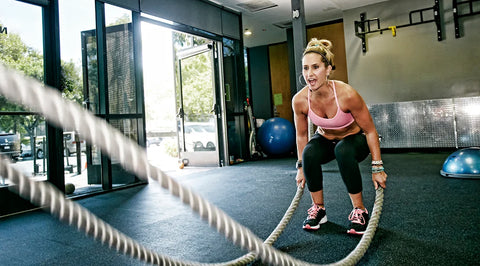Have you ever heard of the term LISS cardio and its benefits? Well, if you haven’t, don’t worry! We’ll tell you all about it in a second.
We also want to compare it to HIIT (High Intensity Interval Training) so you can better understand what training you should do depending on your goals.
It's all about the intensity
Before we completely dive into the subject, let’s talk a bit about exercise intensity. This will help you understand the main differences between LISS and HIIT.
High intensity and low intensity are defined by your heart rate, meaning that the more times your heart beats per minute (bpm), the higher the intensity. Your maximum heart rate decreases with age and you can estimate your maximum by subtracting your age from 220, which is the highest.
Therefore with this information, you can adjust the intensity of your training to get the results you want. Now let’s see which one between LISS or HIIT is best for fat loss and overall fitness.
What is LISS cardio?
LISS responds to Low-intensity steady-state and is a method of cardiovascular exercises in which you practice aerobic activity at a low-to-moderate intensity for a continuous, and usually extended, period. When doing this type of exercise the goal is to keep your heart rate around a steady 50 to 70 percent of your maximum heart rate.
LISS cardio is the opposite of HIIT, which responds to high-intensity interval training. HIIT involves alternating short bursts of intense exercise with little time to recover all in short periods. Usually between 20 to 30 minutes.

What are the benefits of LISS cardio?
Like any form of exercise, Low-intensity steady-state cardio has multiple benefits for you and your overall health including improved blood flow, reduced stress, lower risk of heart disease, and improved brain function. Let’s review the main benefits of LISS cardio.
Fat burning and fat loss
Steady-state training uses fat as fuel instead of using carbs like HIIT training. It’s been proven that continuous aerobic exercise is more effective than HIIT when it comes to improving fat distribution.
For all levels
The best part of LISS is that it is appropriate for all levels since it’s easier to do and way gentler on the body. It doesn’t matter if you’re a beginner, intermediate, or advanced in fitness or if you’re 20 or 60 years old. Everyone can (and has) to do it.
Most intermediate or advanced fitness levels use it as a part of an endurance training program because exercising at a lower intensity for a long time puts less stress on your heart and lungs than a higher intensity workout.
Fast recovery
The steady state allows for easier recovery. Since you’ll be putting less stress on your heart and body, it’s easier and faster for your body to fully recover after a good LISS training session.
It is also a great way to recover after a difficult workout meaning you can use a LISS session as recovery the day after a high-intensity workout.
However, not everything is shiny, it also has a few drawbacks. For example, you’ll need more time, since it requires longer cardio sessions that go from 30 to 60 minutes (ideally 60 minutes of training). Also, you may get bored doing the same exercise at the same intensity for this long, so try to train with a friend or prepare a good playlist to listen to while exercising. If you’re doing the same type of workout quite often, you may increase your risk of overuse injuries so, whenever possible, try to spice it up a little bit.
HIIT vs. LISS
As we’ve seen, HIIT consists of short bursts of effort where you get close to your max heart rate. Followed by slower recovery periods to get your heart rate back down. Whereas LISS is a constant pace at 50-70% of your max heart rate.
Usually, HIIT workouts are shorter in duration due to the taxing nature of maximum effort exercise. On the contrary, LISS workouts can be easily sustained for long durations since they don’t take a significant toll on the body, so their duration generally goes somewhere between 30 to 60 minutes.
One of the advantages of HIIT is that your average rate is higher compared to LISS and that means that you burn more calories. HIIT burns 40-60% more calories per minute than LISS. However, to see which is best for you, we need to look closer.

HIT vs. LISS for fat loss
While it’s true that HIIT burns more calories per minute than LISS, it’s important to know that not all calories are made equal and that not all of them come from the same place. It depends if you’re burning carbs or fat.
Higher-intensity exercise (HIIT) uses carbs as fuel, so naturally, it burns more calories from carbs. While lower intensity exercise (LISS) uses fat as fuel so it burns more calories from fat. Low-intensity exercise burns about 50% more fat than High-intensity training. In addition to burning more fat calories per minute, LISS also lasts for, at least, 30 minutes. So this means that it has more fat-burning potential than HIIT.
So which one should I do?
Well, to decide which training is best for you, you’ll first need to decide your goals. That way you’ll optimize your training sessions and your nutrition as well.
If you’re looking to burn fat you should focus on LISS focusing on having 3 to 5 LISS sessions each week and only limit HIIT to 2 sessions maximum per week. But if what you’re looking for is to have optimal fitness, you should try a mix of both. Try to split up your HIIT sessions up to 3 per week and dom LISS on days you don’t do HIIT.
However, the most important thing to keep in mind is that you won’t see any results unless you’re consistent with your workouts. Consistency is the key to everything. Also, remember to have fun and enjoy each practice!
Other blogs you might enjoy:
- How to Heal Your Gut & Eat Smarter and Improve Your Brain Health with food
- Mindful Eating: What Is It and How To Start





Leave a comment
All comments are moderated before being published.
This site is protected by hCaptcha and the hCaptcha Privacy Policy and Terms of Service apply.